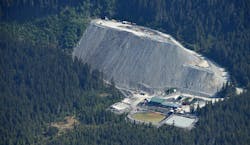JUNEAU, ALASKA, AUG 21, 2019 -- The U.S. Environmental Protection Agency (EPA) has reached three settlements with Coeur Alaska, Inc., over discharge violations from its gold mining operation at Kensington Mine, located 45 miles northwest of Juneau.
As part of the agreement, Coeur Alaska will pay three separate penalties totaling $534,500: a $240,000 penalty for violations of their individual National Pollutant Discharge Elimination System permit for industrial wastewater discharges; a $210,000 penalty for violations of the Multi-Sector General Permit for Stormwater Discharges Associated with Industrial Activity; and an $84,500 penalty for failure to report releases of nitrate compounds under Section 313 of the Emergency Planning and Community Right to Know Act, more commonly known as the Toxics Release Inventory.
According to Ed Kowalski, Director of EPA’s Enforcement and Compliance Assurance Division in Seattle, Washington, large-scale mining operations must diligently comply with all relevant regulations, or people and the environment suffer.
“Coeur Alaska’s Kensington mine generates and manages large volumes of both wastewater and stormwater containing pollutants that can degrade water quality and seriously harm aquatic life,” said Kowalski. “By looking at the entire facility during the multi-media inspection, we had a clearer picture of day-to-day operations. Coeur Alaska can and must do better in order to comply with our fundamental laws that protect people and the environment.”
As part of this agreement, Coeur Alaska Inc. also signed an Administrative Order on Consent for the unauthorized discharges of acid rock drainage into Lower Slate Lake. The Administrative Order on Consent ensured that acid rock drainage would be collected and treated before it is discharged into the Lake. Effective Aug. 1, 2019, the State of Alaska modified Kensington's individual permit to authorize the discharge of residual acid rock drainage into Lower Slate Lake.
Numerous alleged violations were documented in a facility-wide inspection conducted jointly by the EPA’s National Environmental Inspection Center and Alaska Department of Environmental Conservation enforcement officials in 2015. This settlement agreement , which the state supports, resolves numerous violations observed during the inspection and subsequent records review. Those violations include:
- 200 wastewater discharge violations.
- Unauthorized discharge of acid rock drainage into Lower Slate Lake.
- Improper operation and maintenance of sampling equipment.
- Multiple effluent sampling violations.
- Failure to develop a complete Stormwater Pollution Prevention Plan.
- Failure to repair a secondary containment structure for over a year that holds a majority of the facility’s fuel.
- Failure to conduct required monitoring, assessments, inspections and trainings.
- Failure to use proper sample handling and analysis procedures.
- Failure to report releases of nitrate compounds annually from 2013 to 2017.
Mine water discharges that are not properly controlled and treated can harm water quality and aquatic life. By introducing high concentrations of toxic metals or increasing sediment turbidity, fish can be harmed, and eggs can be smothered in stream bottom gravels. When introduced unchecked, high-velocity discharge water can also erode stream banks and cause or contribute to riverbank failure.
By responsibly handling and managing process and stormwater on site and ensuring strict compliance with discharge permit conditions, hard rock mining operations can dramatically reduce their impact to lakes, rivers and streams.


